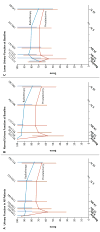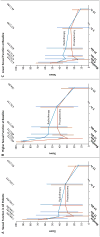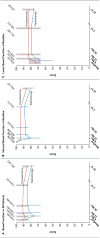Long-term functional outcomes after treatment for localized prostate cancer
- PMID: 23363497
- PMCID: PMC3742365
- DOI: 10.1056/NEJMoa1209978
Long-term functional outcomes after treatment for localized prostate cancer
Abstract
Background: The purpose of this analysis was to compare long-term urinary, bowel, and sexual function after radical prostatectomy or external-beam radiation therapy.
Methods: The Prostate Cancer Outcomes Study (PCOS) enrolled 3533 men in whom prostate cancer had been diagnosed in 1994 or 1995. The current cohort comprised 1655 men in whom localized prostate cancer had been diagnosed between the ages of 55 and 74 years and who had undergone either surgery (1164 men) or radiotherapy (491 men). Functional status was assessed at baseline and at 2, 5, and 15 years after diagnosis. We used multivariable propensity scoring to compare functional outcomes according to treatment.
Results: Patients undergoing prostatectomy were more likely to have urinary incontinence than were those undergoing radiotherapy at 2 years (odds ratio, 6.22; 95% confidence interval [CI], 1.92 to 20.29) and 5 years (odds ratio, 5.10; 95% CI, 2.29 to 11.36). However, no significant between-group difference in the odds of urinary incontinence was noted at 15 years. Similarly, although patients undergoing prostatectomy were more likely to have erectile dysfunction at 2 years (odds ratio, 3.46; 95% CI, 1.93 to 6.17) and 5 years (odds ratio, 1.96; 95% CI, 1.05 to 3.63), no significant between-group difference was noted at 15 years. Patients undergoing prostatectomy were less likely to have bowel urgency at 2 years (odds ratio, 0.39; 95% CI, 0.22 to 0.68) and 5 years (odds ratio, 0.47; 95% CI, 0.26 to 0.84), again with no significant between-group difference in the odds of bowel urgency at 15 years.
Conclusions: At 15 years, no significant relative differences in disease-specific functional outcomes were observed among men undergoing prostatectomy or radiotherapy. Nonetheless, men treated for localized prostate cancer commonly had declines in all functional domains during 15 years of follow-up. (Funded by the National Cancer Institute.).
Figures



Comment in
-
Urological cancer: Life after prostate cancer treatment.Nat Rev Clin Oncol. 2013 Mar;10(3):123. doi: 10.1038/nrclinonc.2013.21. Epub 2013 Feb 12. Nat Rev Clin Oncol. 2013. PMID: 23400001 No abstract available.
-
Functional outcomes after treatment for prostate cancer.N Engl J Med. 2013 Apr 25;368(17):1654. doi: 10.1056/NEJMc1302509. N Engl J Med. 2013. PMID: 23614595 No abstract available.
-
Functional outcomes after treatment for prostate cancer.N Engl J Med. 2013 Apr 25;368(17):1653. doi: 10.1056/NEJMc1302509. N Engl J Med. 2013. PMID: 23614596 No abstract available.
-
Functional outcomes after treatment for prostate cancer.N Engl J Med. 2013 Apr 25;368(17):1653-4. doi: 10.1056/NEJMc1302509. N Engl J Med. 2013. PMID: 23614597 No abstract available.
-
Long-term differences in urinary, bowel and sexual function among men treated with surgery versus radiation for prostate cancer.Asian J Androl. 2013 Jul;15(4):443-4. doi: 10.1038/aja.2013.39. Epub 2013 May 13. Asian J Androl. 2013. PMID: 23665759 Free PMC article. No abstract available.
-
[Long-term quality of life after prostatectomy and percutaneous radiotherapy for localized prostate cancer].Strahlenther Onkol. 2013 Sep;189(9):804-5. doi: 10.1007/s00066-013-0385-3. Strahlenther Onkol. 2013. PMID: 23907136 German. No abstract available.
-
Re: Long-term functional outcomes after treatment for localized prostate cancer.J Urol. 2013 Nov;190(5):1764-5. doi: 10.1016/j.juro.2013.07.084. Epub 2013 Aug 2. J Urol. 2013. PMID: 24120779 No abstract available.
-
Commentary on: "Long-term functional outcomes after treatment for localized prostate cancer." Resnick MJ, Koyama T, Fan KH, Albertsen PC, Goodman M, Hamilton AS, Hoffman RM, Potosky AL, Stanford JL, Stroup AM, Van Horn RL, Penson DF. Department of Urologic Surgery and the Center for Surgical Quality and Outcomes Research, Vanderbilt University, Nashville, TN.: N Engl J Med 2013;368(5):436-45. doi: 10.1056/NEJMoa1209978.Urol Oncol. 2014 May;32(4):513-4. doi: 10.1016/j.urolonc.2013.12.010. Urol Oncol. 2014. PMID: 24767688
References
-
- Alicikus ZA, Yamada Y, Zhang Z, et al. Ten-year outcomes of high-dose, intensity-modulated radiotherapy for localized prostate cancer. Cancer. 2011;117:1429–37. - PubMed
-
- D'Amico AV, Whittington R, Malkowicz SB, et al. Biochemical outcome after radical prostatectomy, external beam radiation therapy, or interstitial radiation therapy for clinically localized prostate cancer. JAMA. 1998;280:969–74. - PubMed
-
- Birkhahn M, Penson DF, Cai J, et al. Long-term outcome in patients with a Gleason score ≤6 prostate cancer treated by radical prostatectomy. BJU Int. 2011;108:660–4. - PubMed
-
- Zeliadt SB, Moinpour CM, Blough DK, et al. Preliminary treatment considerations among men with newly diagnosed prostate cancer. Am J Manag Care. 2010;16(5):e121–e130. - PubMed
Publication types
MeSH terms
Grants and funding
LinkOut - more resources
Full Text Sources
Other Literature Sources
Medical
